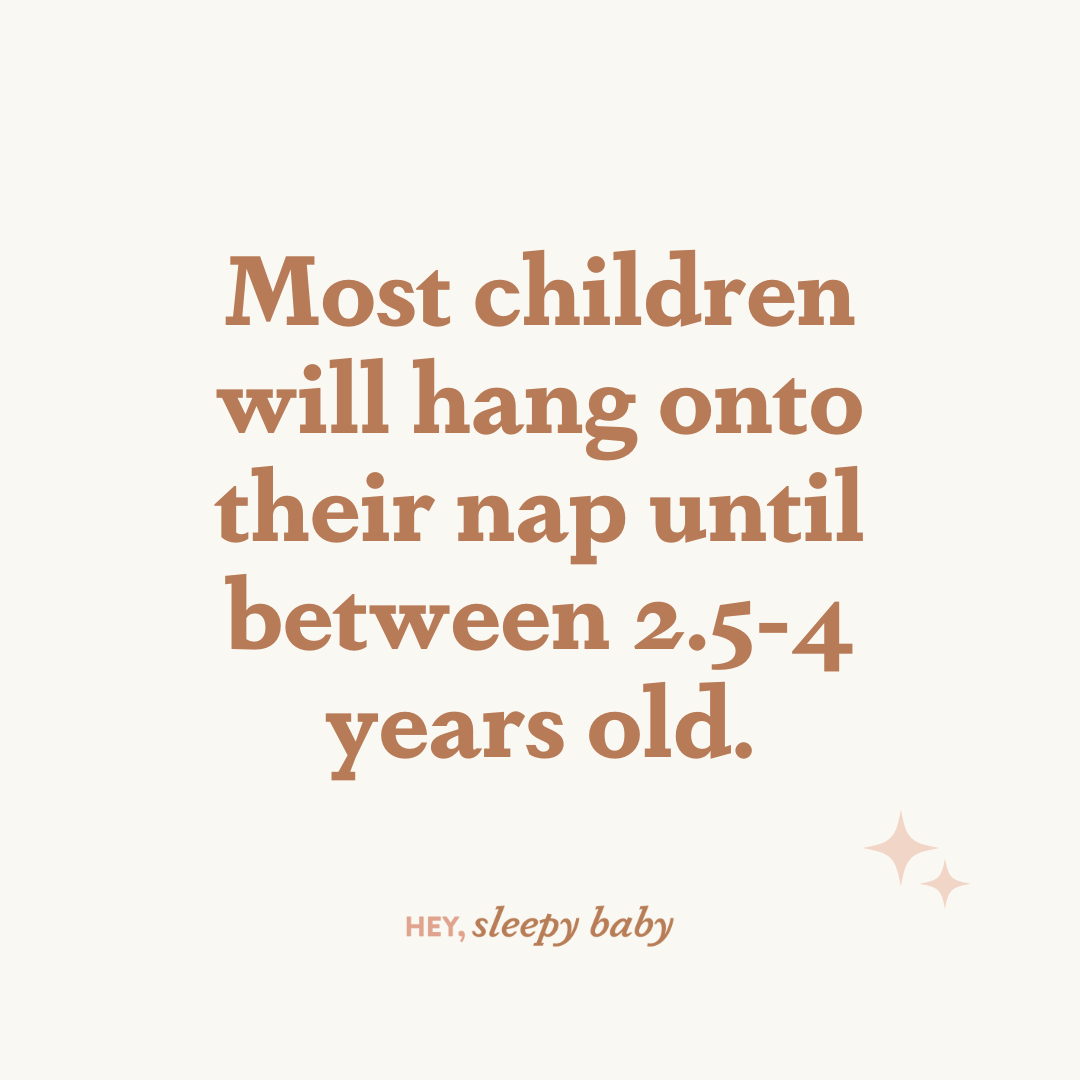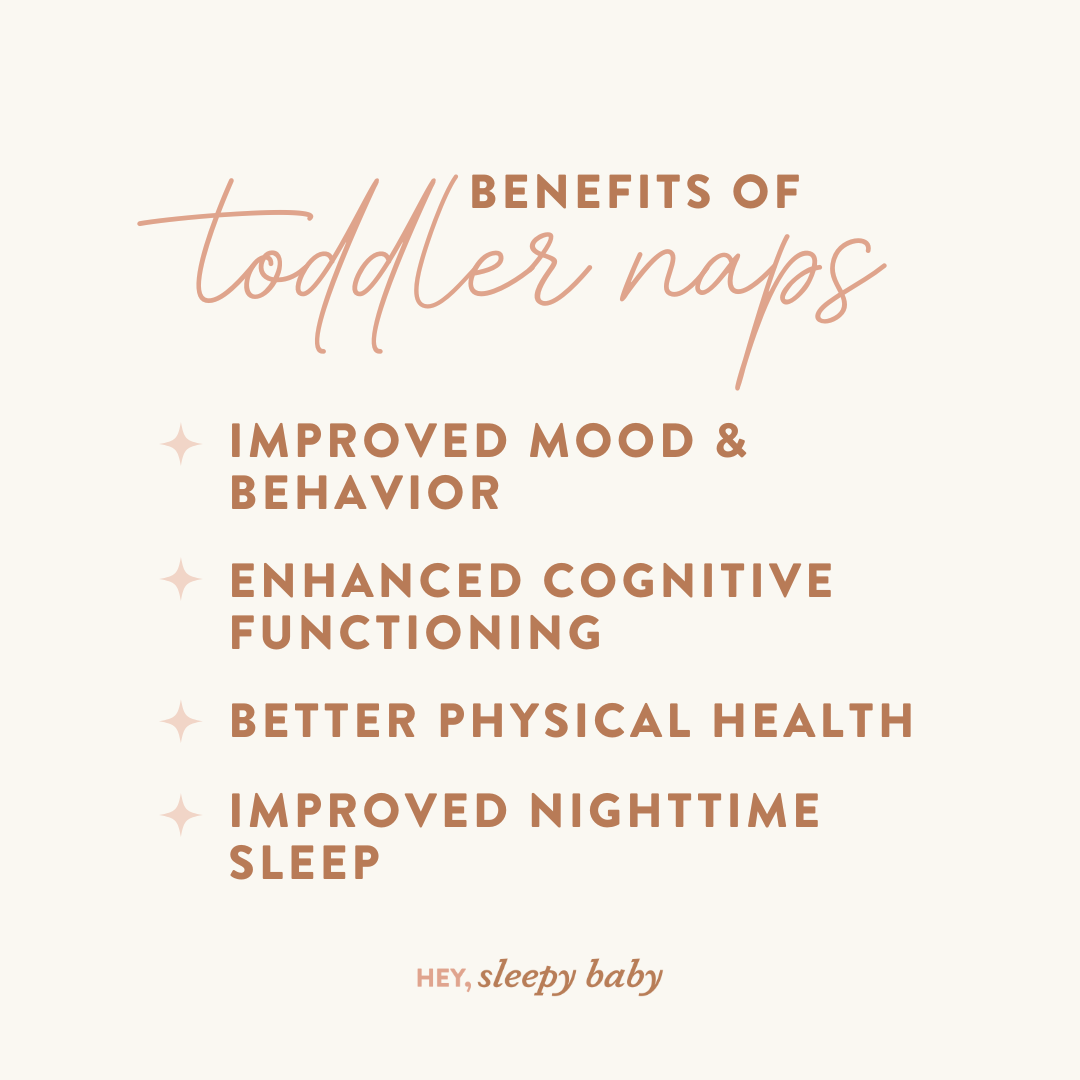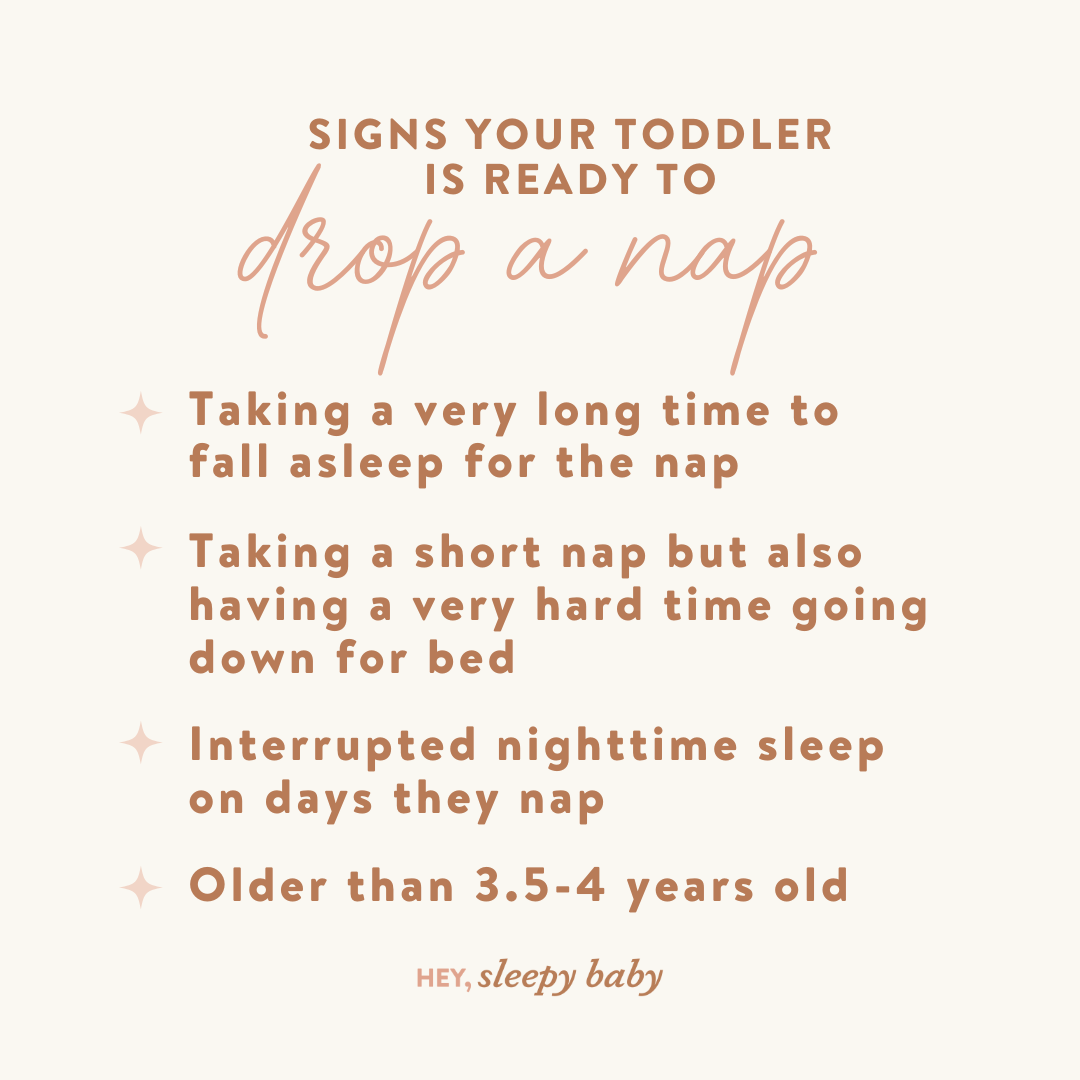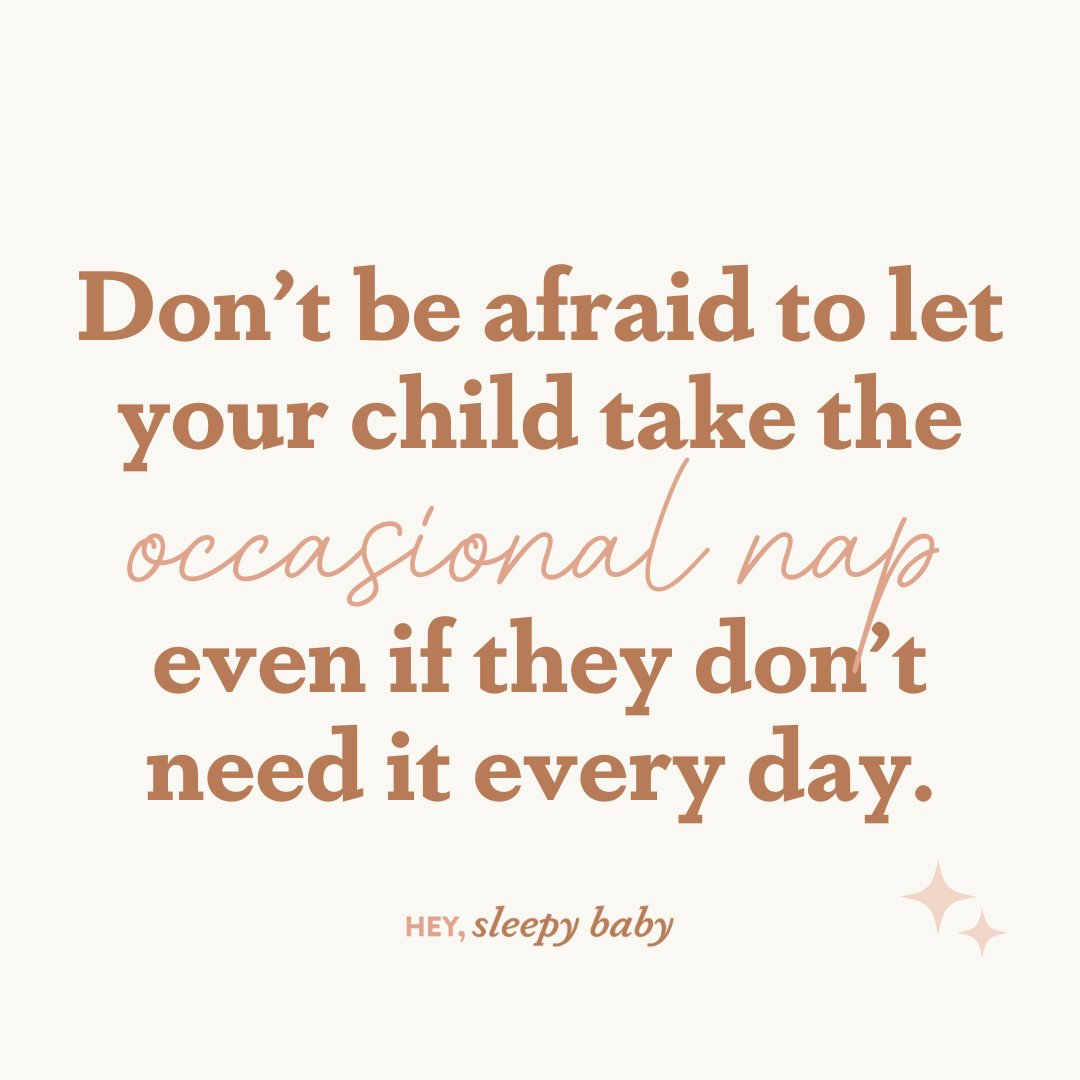I'm Rachael
Mom of 3 & Baby Sleep Expert with Big Sis Energy
& I’VE DONE ALL THE RESEARCH FOR YOU ALREADY.
Better sleep for the entire family
BROWSE COURSES
hey!
is my toddler ready to stop napping?
June 6, 2023
in this post:
when do toddlers stop napping?
The timing of nap transitions is influenced by various factors, including genes (although minimally), environment, culture, and individual sleep needs. Most children will hang onto their nap until between 2.5-4 years old, though for some with lower sleep needs, they may stop napping even younger. High sleep needs nap lovers may continue napping well over 5 if given the chance! This makes sense, since some research actually suggests that nap transitions have more to do with brain development than a child’s age.

There’s some controversy around dropping naps prematurely, and I get it. Naps are important for little ones, and they provide a nice break for us parents! Sure, they might seem like a minor part of your toddler’s day, but trust me, they can make a huge difference in their mood, behavior, and overall health. The growing evidence highlights the importance of providing all young children with the opportunity to nap. With that being said, children are humans with varying needs. While some might really need a nap until they’re 5 years old, others are ready to drop it closer to age 2. There’s no “right” age to stop napping, so instead I suggest looking for the signs which I will explain in this post, and to compensate for that lost daytime sleep with great sleep hygiene in the evening, an earlier bedtime, and a strong bedtime routine.
It’s usually my recommendation to try and get the nap to happen if you can, and if your child is “fighting” their nap, give it a couple of weeks to see if it’s not just a phase. It’s common for this to happen during sleep regressions, especially at ages 12, 18, and 24 months. If they do seem to need less daytime sleep, start with offering a short nap vs. taking it away completely at first. You could also try a “hybrid” schedule where naps happen on busy school days or at daycare but not the weekend or vice versa. Lots of parents are eager to drop the nap prematurely, thinking it will make bedtime and nights go better (meaning faster). This is true for some but shouldn’t be a blanket recommendation without trying out some other things first.
what are the benefits of napping in toddlers?
Research has shown numerous benefits associated with regular napping in toddlers, including:

-
Improved mood and behavior: Studies have found that toddlers who take regular naps are less cranky and have better emotional regulation than those who don’t nap. Napping can also reduce the likelihood of tantrums and improve overall behavior. This is because napping provides the brain an opportunity to rest and recharge, promoting better emotional and behavioral control.
-
Enhanced cognitive functioning: Naps have been shown to improve memory consolidation, attention, and learning in toddlers. One study found that toddlers who napped regularly performed better on a task that required visual-spatial recall than those who didn’t nap.
-
Better physical health: Napping can help reduce fatigue and boost immunity, which can improve overall physical health in toddlers. A study published in the Archives of Pediatrics and Adolescent Medicine found that toddlers who napped regularly had a lower risk of obesity than those who didn’t nap.
-
Improved nighttime sleep: Studies have shown that toddlers who nap regularly tend to have longer and more restful nighttime sleep than those who don’t nap. This could be because overtiredness can disrupt nighttime sleep but can also mean that kids with higher sleep needs both nap more AND sleep more overnight.
Overall, the research suggests that napping can provide several important benefits for toddlers. However, it’s also important to note that children have varying sleep needs, and not every child will continue to nap into the preschool years. Some lower sleep needs children are ready to drop their nap earlier than most, and you shouldn’t be afraid to follow your child’s lead and do what works best for them!

signs my toddler is ready to stop napping
Some signs that your child is ready to drop their nap completely include:

-
taking a very long time to fall asleep for the nap
-
taking a short nap but also having a very hard time going down for bed
-
interrupted nighttime sleep on days they nap, such as increased nighttime waking, split nights or early morning waking
-
being older than 3.5- 4 years old and experiencing any of the above
If your toddler isn’t exhibiting these signs, they likely still need a nap in their day. If your toddler is extremely fussy, hyperactive, or clumsy, extra emotional, by the late afternoon / evening, this could be a sign that they would still benefit from a nap, even if it’s short and means bedtime is a bit later. It’s common for toddlers to go through phases of nap refusal during “sleep regressions” around ages 18 months and two years, but almost all kids these ages still need a nap. Try and keep your routines consistent.
things to try before dropping the nap
Before you drop the nap all together, you can experiment with a couple things:
-
If bedtime is super hard, try moving the nap to earlier in the day, if they’ll fall asleep. This will create a bigger wake window and allow more sleep pressure to build before bedtime.
-
If your child won’t fall asleep at the earlier OR regular time, but you want to try keeping the nap, you can try capping it before stopping it all together. Try cutting it down to an hour, or even 15-30 minutes.
-
If you feel that your child still needs the nap, you may need to shorten their nighttime sleep to make it happen. This usually happens by waking them a bit earlier in the morning, so that they have more time to build sleep pressure by the afternoon. You could also keep the nap and just embrace a later bedtime for a while.
-
You may also need to support them to sleep more than you used to, or in a different way. Car or stroller naps are usually a great way to sneak it in. Keep in mind this might make bedtime later than you’d like, but it’s temporary!
-
You can also set up “Quiet Time” in place of the nap so your child still has time to rest and recharge and so do you! They might actually fall asleep sometimes, too. Keep this a low-pressure time rather than fighting with them to go to sleep. Listen to audio books or music (check out my honest review of popular audio players for kids) / meditation or give them a pile of special Quiet Time books to look at in their bed.
-
Some kids will have irregular nap schedules for a long time and may take a nap only on super busy days or weekends. This is ok- you can just adjust bedtime earlier or later accordingly! A longitudinal study of early nap transitions support that transitions take place over a number of months, with naps gradually reducing in frequency and length over time. It’s OK if this isn’t an overnight process!
If none of the above works and you’ve been trying for more than a couple of weeks, it might be time to mourn the nap. But, when the nap is gone for good, bedtime will likely move earlier by as much as an hour or two or even more, giving you some much needed alone time! This is the silver lining, friends!
@heysleepybaby Does your little one still nap!? Also can’t get enough of this songgggggg! #droppingthenap #toddlernap #fightingnaps #toddlersleepschedule ♬ original sound – Braden Bales
what should I expect when my toddler stops napping?
Most of the time, if your toddler is ready to stop napping, the nighttime sleep will consolidate to make up for this. For example, when my daughter dropped her nap, she went from about 10.5 hours of overnight sleep to 12. If this doesn’t happen after a few days up to a couple of weeks, you’ll want to consider adding the nap back in to be sure your little one is getting enough sleep.
Of course, every child is different, and what works for one might not work for another. But the bottom line is this: naps can be important for toddlers, and taking the time to figure out the right nap schedule for your child can make a big difference in their overall wellbeing. This is why I’ll almost always recommend trying to cap the nap first, for at least a few days, before totally dropping it, at least for children under two and a half to three years old.

REMEMBER- sleep isn’t always linear! Your toddler may start school or childcare and need the nap again because they are so busy. They might still nap in the car if driving around in the afternoon, or on the weekends when home with you. It’s OK to take things day by day- we can’t have a “perfect” schedule that’s the same every single day. Kids needs may change depending on life circumstances. It’s fine to let your child nap even if they’ve officially “dropped it” when:
-
they start childcare and there is a designated nap or rest time
-
they are in the car and falling asleep is unavoidable
-
it’s the weekend and they take a nap with a sibling or parent
-
they’re sick
-
they just seem to need some extra sleep!
Don’t be afraid to let your child take the occasional nap even if they don’t need it every day. Think of it like us adults- even if we don’t have a nap as part of our daily routine anymore, sometimes you just NEED one, and that’s ok! Just expect that bedtime might be a bit later (sometimes by as much as a couple of hours) on the days your child does take a nap. To avoid bedtime becoming TOO late, let your child nap but keep it to a quick “power nap” of under 45-60 minutes.
how to cope with no naps
While your child adjusts to no naps, they may be extra cranky in the afternoons. To cope with no naps:
-
Avoid screens in favor of outside time, free play, art, or books. Screen time might seem like a good way to get a break, and maybe it is, but for some kids it can actually overstimulate and make those late afternoon meltdowns worse.
-
During the usual meltdown / nap time, try getting outside, having a snack, or cuddling together with some books vs. scheduling appointments, activities, etc. during that time.
-
Try to avoid over-scheduling in the late afternoon and evening time- they will likely be tired, cranky, and ready for bed earlier than normal.
Remember that everything is a phase! Even just a few weeks or a couple of months can mean the difference of napping vs. no napping, so be flexible and hang in there!
key points about nap transitions
-
Toddlers typically need around 11-14 hours of sleep per 24-hour day, including naps and nighttime sleep.
-
Most toddlers will need at least one nap per day until they’re around 3 years old.
-
The timing of naps will depend on your child’s age and schedule, but a good rule of thumb is to aim for a midday nap that’s about 1-2 hours long.
-
Pay attention to your child’s cues and adjust their nap schedule as needed. If they seem overtired or cranky, they may need an earlier or longer nap. If they’re fighting the nap HARD and then bedtime is also getting pushed later and later as a result, it could be time to cap the nap (make it just a quick “power” nap”) or consider dropping the nap all together and making bedtime at least 1-1.5 hours earlier.
If you need some guidance with tough bedtimes and naps and you’re not sure what the culprit is, the Better Bedtimes Guide is here for you. Whether your goal is independent sleep or just a smoother, calmer evening, this guide will give you all the tools and strategies you need to make bedtime the best part of the day in your home.
If you are looking to move on from cosleeping or to make other supported changes to your little one’s sleep, then check out our Tender Transitions Course. But the Toddler Bundle includes the Tender Transitions Course AND the Better Bedtimes Guide!
Featured
Responsive sleep tips and support for parents of multiples or twins.
What are floor beds? When to use them? And How to use them?
Before you start changing anything it’s important that you have ruled out any underlying reasons why your infant might have such a strong link to staying latched.
Between the ages of 2-3, many toddlers will experience a heightened level of fear and anxiety. They go through a big developmental leap in their imagination but their ability to distinguish between reality and fantasy doesn’t quite match up! Cue the sudden influx of questions about monsters…
Here are my best tips and tricks to help you bridge this transition. I found that I needed to prepare myself as a mom and prepare my baby. So here are my practical tips for preparing the YOU!
Here are my best tips and tricks to help you bridge this transition. I found that I needed to prepare myself as a mom and prepare my baby. So here are my practical tips for preparing the YOU!
Sources:
-
Spencer RMC, Riggins T. Contributions of memory and brain development to the bioregulation of naps and nap transitions in early childhood. Proc Natl Acad Sci U S A. 2022 Nov;119(44):e2123415119. doi: 10.1073/pnas.2123415119. Epub 2022 Oct 24. PMID: 36279436; PMCID: PMC9636905. https://pubmed.ncbi.nlm.nih.gov/36279436/
-
Gruber, R., Cassoff, J., Frenette, S., Wiebe, S., & Carrier, J. (2012). Impact of sleep extension and restriction on children’s emotional lability and impulsivity. Pediatrics, 130(5), e1155-e1161. https://pubmed.ncbi.nlm.nih.gov/23071214/
-
Lokhandwala, S., & Spencer, R. M. C. (2021, March). Slow wave sleep in naps supports episodic memories in early childhood. Developmental science. https://www.ncbi.nlm.nih.gov/pmc/articles/PMC7988587/
-
Touchette, E., Petit, D., Séguin, J. R., Boivin, M., Tremblay, R. E., & Montplaisir, J. Y. (2007). Associations between sleep duration patterns and behavioral/cognitive functioning at school entry. Sleep, 30(9), 1213-1219. https://www.ncbi.nlm.nih.gov/pubmed/17910389
Was this helpful? Save it for later!

binge reads
We think you'll love these
You deserve to the
baby stage, not just "survive it."
And you DON'T have to sacrifice your values, ignore your instincts, or force yourself to follow a method you don't align with just to get your baby back to sleep.
I’m here to help you create a restful, sustainable sleep environment that honors both your baby’s needs AND your own (without the stress OR the guilt!) because, no, you don’t have to choose between the two.
enjoy!
BABY SLEEP COURSES →
BABY SLEEP CONSULTS →
Wish you could help your baby sleep better without resorting to sleep training? Download my FREE guide to a good night’s sleep and learn 8 simple, science-backed tips for supporting your child’s needs.
Traditional sleep training methods don’t have to be your solution to better sleep.
SLEEP TRAINING ISN’T THE ONLY WAY TO GET GOOD SLEEP
Hey, I'm Rachael and Hey, Sleepy Baby is for parents who want to get their nights back, without sleep training their babies.
NO ONE TOLD US POD
explorING the untold truths of parenting








